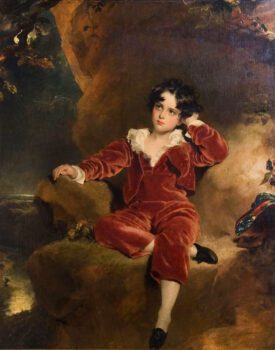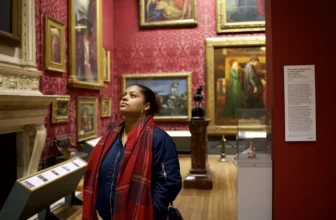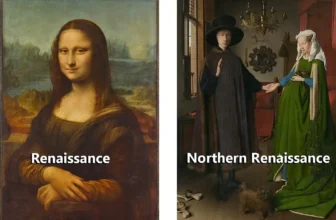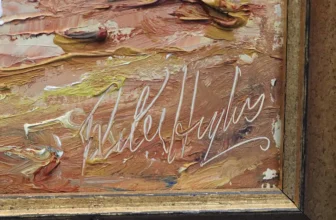The Red Boy Painting by Thomas Lawrence
Among the masterpieces of early 19th-century portraiture, The Red Boy, officially titled Portrait of Charles William Lambton, painted by Sir Thomas Lawrence in 1825, stands as one of the most iconic and enduring images in British art. This celebrated painting has captivated audiences for generations, not merely for its visual beauty but also for its emotional depth, symbolic richness, and historical significance.
In this extensive exploration, we’ll delve into what The Red Boy painting is all about, analyze its symbolism and themes, interpret its artistic style and importance, discuss the artist behind the work, examine its modern value and location, and uncover the reasons for its lasting legacy.
Who Painted The Red Boy?
The creator of The Red Boy is Sir Thomas Lawrence (1769–1830), an eminent English portrait painter and the fourth president of the Royal Academy. He was widely recognized during his lifetime as the leading portraitist of the Regency era. His subjects included royalty, aristocrats, and political figures, and his skill in capturing character, drama, and elegance earned him international fame.
Lawrence began painting professionally in his teens and quickly rose through the ranks of English artists, succeeding Sir Joshua Reynolds. His portraits were known for their psychological insight, vibrant color palettes, and refined technique, characteristics that are masterfully showcased in The Red Boy.
What Is The Red Boy Painting All About?
The Red Boy depicts Charles William Lambton, the eldest son of John George Lambton, 1st Earl of Durham. The boy was approximately seven years old at the time of the painting. The work was commissioned by the boy’s father, who was a wealthy politician and aristocrat, seeking a portrait of his heir that reflected both nobility and innocence.
In the painting, Charles is shown seated on a rocky shoreline with a stormy sky behind him. He is dressed in an opulent crimson velvet suit with a white lace collar, his expression one of introspection or contemplation. The composition and pose are neoclassical in style, yet filled with the Romantic flair that Lawrence was known for, imbued with mood, emotion, and narrative suggestion.
What Is Happening in The Red Boy Painting?
At first glance, The Red Boy appears to be a simple portrait of a young aristocratic child. However, a closer look reveals that Lawrence intended more than just a likeness.
The boy is seated in a dramatic landscape, with the sea and clouds churning behind him. This backdrop isn’t random, it sets a tone. The tension between the calm pose of the child and the tempestuous environment around him creates a powerful contrast. It symbolizes the vulnerability of youth in a turbulent world. Charles appears pensive, perhaps even melancholy, suggesting a reflective or existential mood rarely depicted in children’s portraits.
Moreover, the setting is not just dramatic, it’s allegorical. The sea often represents the unknown, life’s challenges, or even fate. Placing a young boy at the edge of this boundless element might symbolize his future, responsibilities, or the weight of expectation, particularly as the heir to a prominent family.
Symbolism and Interpretation of The Red Boy Painting
1. The Color Red
The most obvious and striking element of the painting is Charles’s crimson outfit. The vibrant red suit dominates the composition and gives the painting its common title.
In art, red is a powerful color associated with passion, vitality, strength, and sometimes danger or sacrifice. For a child, such a strong color can be read in multiple ways. It may suggest the nobility of blood (as Charles was an aristocrat), the intensity of youthful spirit, or even an omen of a passionate or turbulent life ahead. It could also be a subtle nod to the political power of the family, Charles’s father was an influential reformist politician.
2. The Stormy Sky and Ocean
As noted, the backdrop of the sea and storm clouds imbues the work with a Romantic sense of nature’s power and the fragility of human life. It elevates the portrait from a simple representation to a poetic meditation on childhood, identity, and destiny.
The Romantic period, which influenced Lawrence, often juxtaposed human emotion with the grandeur of nature. Here, the storm does not dominate Charles but frames him, hinting at resilience or a quiet strength.
3. The Boy’s Pose and Expression
Charles is not smiling; his gaze is distant. He is looking away from the viewer, which was unusual for child portraits at the time. Most children were portrayed with cheerfulness or docility. Instead, Charles appears contemplative and mature beyond his years.
This might reflect the pressures placed upon children of aristocratic families. It also contributes to the universal theme of lost innocence, or the cusp of transition between childhood and adult responsibilities.
What Type of Art Is The Red Boy Painting?
The Red Boy is a portrait, but more specifically, it falls within the Romantic portraiture style with elements of neoclassicism.
Artistic Characteristics:
Medium: Oil on canvas
Style: Romanticism
Subject Matter: Portrait with narrative and allegorical overtones
Technique: Smooth brushwork, luminous color palette, atmospheric background
Lawrence’s work bridged the late 18th century’s neoclassical ideals and the early 19th century’s emotionalism and individualism. He often elevated portraits to dramatic, almost theatrical compositions, which helped communicate the personality and psychological depth of the sitter.
Historical and Cultural Context
When The Red Boy was painted in 1825, Britain was at the height of its imperial power and entering the Industrial Revolution. The aristocracy, while still dominant, was being challenged by emerging social classes, reform movements, and new political ideologies.
John Lambton, Charles’s father, was a progressive politician who would later draft the Durham Report, a document that helped shape modern Canadian government. Commissioning a grand, emotionally rich portrait of his son can be seen not only as a family memento but as a political and social statement, a depiction of the next generation of leadership and reform.
Tragically, Charles William Lambton died at the young age of 13, just six years after the painting was completed. This loss lends a poignant layer of meaning to the portrait. What was once a celebration of youth and future potential became a memorial of a life cut short.
How Much Is The Red Boy Painting Worth?
The value of The Red Boy has grown significantly over time, not just because of its artistic merit, but also due to its historical resonance and the fame of its painter.
While The Red Boy is not currently for sale (as it belongs to a public collection), its insured value and market estimation have ranged from £10 million to £20 million, based on comparable works by Thomas Lawrence and other high-profile British portraits from the period.
In the art market, works by Sir Thomas Lawrence have sold for millions, with some high-end portraits achieving auction prices well over £3 million, depending on the subject and provenance. Given its iconic status and cultural importance, The Red Boy would undoubtedly attract significant interest if it were ever placed on the open market.
Where Is The Red Boy Painting Today?
As of today, The Red Boy is part of the permanent collection of the National Gallery in London.
It was acquired in 2021 by the gallery, making headlines as the first acquisition funded through a public appeal with the support of the Art Fund and donations from art lovers and institutions.
The painting was unveiled at the gallery in 2022 and has since become one of its most beloved pieces, frequently featured in exhibitions, educational programs, and publications. The acquisition was seen as a major cultural win, bringing this important artwork into the public domain and ensuring its preservation for future generations.
Cultural Legacy and Media Appearance
The Red Boy reached new heights of public recognition in recent years, thanks in part to its selection by the Royal Mail in 2022 for a commemorative stamp. This marked the first time a work of art was featured on a British second-class stamp, bringing it into the hands, and homes, of millions.
This symbolic gesture elevated the painting from an elite portrait to a national treasure, reflecting how deeply embedded it has become in British cultural identity.
It’s also widely referenced in academic texts, exhibitions on Romantic art, and discussions of childhood representation in visual culture.
Why The Red Boy Still Matters
At its heart, The Red Boy is far more than a portrait. It’s a deeply human image, tender, dramatic, and full of unspoken emotion. Thomas Lawrence’s masterful hand created a picture that captures not just the likeness of a young boy but the spirit of a time, a family’s hope, and the universality of youthful innocence touched by the gravity of life.
Through color, composition, and expression, The Red Boy resonates with themes of legacy, identity, vulnerability, and the intersection of public and private life. It is a testament to Lawrence’s genius that nearly two centuries later, the painting still speaks to us, inviting reflection and wonder.
Whether viewed as a personal memorial, an artistic achievement, or a cultural icon, The Red Boy endures, and in doing so, continues to affirm the power of portraiture to transcend time.




